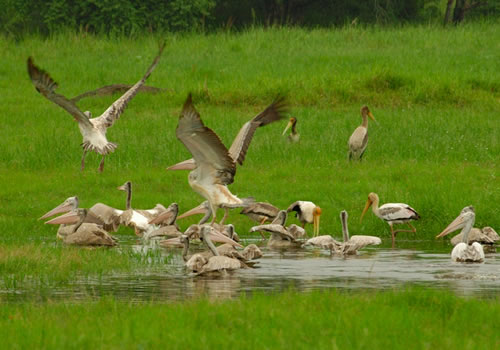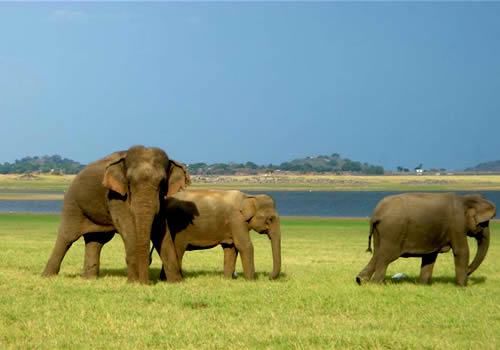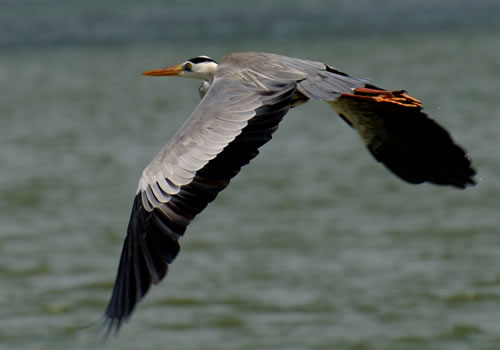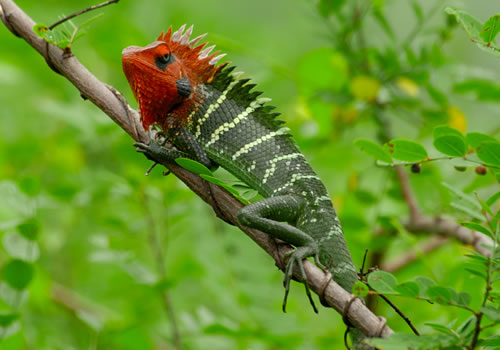Minneriya Giritale National Park (8890 ha) with magnificent ancient Minneriya man-made reservoir (3000 ha) stealing the limelight, is located in close proximity to three more wild life parks of Sri Lanka Holidays: Kaudulla National Park to the north, Wasgomuwa national Park to the south and Flood Plains National Park to the north-east. Furthermore Minneriya Giritale National Park is situated within the famed Cultural Triangle of Sri Lanka that features no less than five UNESCO World Heritage Sites (Culture): Anuradhapura to the north-west, Polonnaruwa to the south-east, Sigiriya to the south-west, Golden Dambulla Rock Cave Temple to the south-west and Kandy to the further south of Dambulla.
Reaching Minneriya-Giritale National Park
Minneriya–Giriatale National Park has a very convenient gateway: Habarana. Habarana, an important transportation hub of the cultural triangle is the intersection of A6 main road of Colombo-Ambepussa-Habarana-Trincomalee and A13, A11 main road that runs from Anuradhapura to Polonnaruwa via Habarana and Minneriya. Minneriya National Park, located 182 km away from Colombo, though in the utter wilderness, can be reached by railway too. Minneriya railway station, which is close to the entrance of the park, is on line that runs from Colombo to Trincomalee via Polonnauwa. Minneriya railway station is between the railway station of Gal Oya Junction (close to Kaudulla National Park) and Hingurakgoda railway station. This Gal Oya Junction in Polonnaruwa district mentioned herein oughtn’t be confused with famous Gal Oya National Park in Ampara district)
Minneriya–Giriatale National Park has a very convenient gateway: Habarana. Habarana, an important transportation hub of the cultural triangle is the intersection of A6 main road of Colombo-Ambepussa-Habarana-Trincomalee and A13, A11 main road that runs from Anuradhapura to Polonnaruwa via Habarana and Minneriya. Minneriya National Park, located 182 km away from Colombo, though in the utter wilderness, can be reached by railway too. Minneriya railway station, which is close to the entrance of the park, is on line that runs from Colombo to Trincomalee via Polonnauwa. Minneriya railway station is between the railway station of Gal Oya Junction (close to Kaudulla National Park) and Hingurakgoda railway station. This Gal Oya Junction in Polonnaruwa district mentioned herein oughtn’t be confused with famous Gal Oya National Park in Ampara district)
Entrance to the Minneriya-Giritale National Park
Entrance to the Minneriya-Giritale National Park cannot get any better: it is where the A11 main road touch the railway line.
Entrance to the Minneriya-Giritale National Park cannot get any better: it is where the A11 main road touch the railway line.
Vegeation at Minneriya Giritale National Park
The park has wide range of habitat types, from dry tropical forest to wetlands, grassland and terrain earlier used for slash-and-burn (chena) cultivation.
The park has wide range of habitat types, from dry tropical forest to wetlands, grassland and terrain earlier used for slash-and-burn (chena) cultivation.
Best time to Visit Minneriya Giritale National Park
Sri Lanka Holidays wild life parks afford the sight of herds of wild elephants and other mammals throughout the year. However during the period of May to October (dry season of north central and eastern plains) Sri Lanka Holidays tourists are afforded the grand spectacle of a vast gathering of wild elephant. The gathering of elephants should not be mistaken for migration of elephants from the nearby wild life parks. The gathering is a phenomenon unique to Minneriya Giritale National Park. Kaudulla National Park has its own ancient irrigation reservoir called Kaudulla reservoir; Giritale sanctuary is located on the banks of Giritale reservoir; Wasgomuwa National Park is sandwiched between River Mahaweli ganga, the largest river of Sri Lanka and River Amban Ganga; Flood Plains National Park has Mahaweli ganga dividing it into two halves all the way to Somathiya Chatiya National Park to further north-east. In spite of the water bodies in and around the other national parks, elephants therein have found that the open grassland on the banks of the vast ancient Minneriya irrigation reservoir is the merry land to run riot during the dry season: drink and bath; feast and play; jostle and hustle to the content of their jumbo hearts.
Sri Lanka Holidays wild life parks afford the sight of herds of wild elephants and other mammals throughout the year. However during the period of May to October (dry season of north central and eastern plains) Sri Lanka Holidays tourists are afforded the grand spectacle of a vast gathering of wild elephant. The gathering of elephants should not be mistaken for migration of elephants from the nearby wild life parks. The gathering is a phenomenon unique to Minneriya Giritale National Park. Kaudulla National Park has its own ancient irrigation reservoir called Kaudulla reservoir; Giritale sanctuary is located on the banks of Giritale reservoir; Wasgomuwa National Park is sandwiched between River Mahaweli ganga, the largest river of Sri Lanka and River Amban Ganga; Flood Plains National Park has Mahaweli ganga dividing it into two halves all the way to Somathiya Chatiya National Park to further north-east. In spite of the water bodies in and around the other national parks, elephants therein have found that the open grassland on the banks of the vast ancient Minneriya irrigation reservoir is the merry land to run riot during the dry season: drink and bath; feast and play; jostle and hustle to the content of their jumbo hearts.
Minneriya Birdlife
Minneriya National Park is home to no less than 160 species of birds. A visit to the bund of the enormous Minnerya irrigation reservoir is bound to be great joy to the bird enthusiasts, birders and ornithologists. King fishers and flycatchers, of many different sizes and degrees of brilliancy keep vigil over the shores of the lake. In the backdrop of contrasting vegetation and habitats of the Minneriya Wildlife Park, an enormous array of birds could be sighted. Among the migrating birds are Common sandpiper, Woodsand piper, Kentish Plovers. Malabar-pied Hornbills, Rufus Woodpecker the globally endangered Lesser Adjutant are among the forest birds. Add to these are of course the endemics to Sri Lanka: Sri Lanka Hanging Parrot, Crimson-fronted Barber, Sri Lanka Grey Horn bill, Sri Lanka Green Pigeon, Sri Lanka Jungle Fowl, Brown-capped Babbler, Emerald Dove, Green Imperial Pigeon.
Minneriya National Park is home to no less than 160 species of birds. A visit to the bund of the enormous Minnerya irrigation reservoir is bound to be great joy to the bird enthusiasts, birders and ornithologists. King fishers and flycatchers, of many different sizes and degrees of brilliancy keep vigil over the shores of the lake. In the backdrop of contrasting vegetation and habitats of the Minneriya Wildlife Park, an enormous array of birds could be sighted. Among the migrating birds are Common sandpiper, Woodsand piper, Kentish Plovers. Malabar-pied Hornbills, Rufus Woodpecker the globally endangered Lesser Adjutant are among the forest birds. Add to these are of course the endemics to Sri Lanka: Sri Lanka Hanging Parrot, Crimson-fronted Barber, Sri Lanka Grey Horn bill, Sri Lanka Green Pigeon, Sri Lanka Jungle Fowl, Brown-capped Babbler, Emerald Dove, Green Imperial Pigeon.
Minneriya Mammals
Minneriya National Park provides sanctuary to 24 species of mammals: Leopards, Spotted Deer, Sambar Deer, Wild Boar, Wild Buffalo, Grey Langers, Purple-faced Monkeys, Porcupine, Indian Pangolin and Mongoose. Oh! Yes the elephants, herds of elephants.
Minneriya National Park provides sanctuary to 24 species of mammals: Leopards, Spotted Deer, Sambar Deer, Wild Boar, Wild Buffalo, Grey Langers, Purple-faced Monkeys, Porcupine, Indian Pangolin and Mongoose. Oh! Yes the elephants, herds of elephants.
Minneriya Amphibians and Reptiles
Minneriya Wild Life Park is home to nine species of Amphibians: common tree frog and slender wood frog are commonly seen. Among the 25 species of repitiles known to have found sanctuary in the park are Red-lipped Lizard (endemic), water monitor and land monitor, mugger Crocodile.
Minneriya Wild Life Park is home to nine species of Amphibians: common tree frog and slender wood frog are commonly seen. Among the 25 species of repitiles known to have found sanctuary in the park are Red-lipped Lizard (endemic), water monitor and land monitor, mugger Crocodile.
Minneriya Accommodation Options
Sri Lanka Holidays tourists visiting Minneriya Park afforded with the opportunities to enjoy the luxury of eco-oriented lodges and hotels in the wilderness of Habarana, Giritale and Kandalama and Dambulla. At the high end of the range are Hetitance Kandalama at Kandalama, Cinnamon Lodge at Habarana, Chaaya Village at Habarana , Deer Park Hotel at Habarana and Amaya Lake at Dambulla.
Sri Lanka Holidays tourists visiting Minneriya Park afforded with the opportunities to enjoy the luxury of eco-oriented lodges and hotels in the wilderness of Habarana, Giritale and Kandalama and Dambulla. At the high end of the range are Hetitance Kandalama at Kandalama, Cinnamon Lodge at Habarana, Chaaya Village at Habarana , Deer Park Hotel at Habarana and Amaya Lake at Dambulla.
Minneriya Reservoir
According to Rajavaliya (Sinhala: line of kings or genealogy of rulers), a Sinhalese historical chronicle written in Sinhala in Sri Lanka (Mahawamsa, the Great Genealogy was written in Pali verse in Sri Lanka), that narrates from the earliest times up to the reign of King Vimadharmasuriya the second at Kandy (1684-1706 AD), Minneriya irrigation reservoir of Sri Lanka Holidays was built by King Mahasena (276-302 AD), who reigned at Anuradhapura. Rajavaliya narrates: king Mahasena taking the services of Yakkas, constructed the Minneriya irrigation reservoir and dammed up the River Kara-ganga channeling its water to Minneriya. Considering the signs indicated by gods, he constructed an anicut across the River Talwatu-oya and bringing under cultivation twenty thousand paddy fields and caused to be constructed seventeen irrigation reservoirs, namely; Muvagamuva, Suralla, Didora, Mahaminiya, Kokkavava, Puskumbura, Rattalla, Mahaluvava, Suluguruva, Kalavana, Kimbulvana, Vatamodaragalla, Belipitiya, Vadunnava, Siruvalya, Rantisa and Minihiriya, taking the services of Yakkas during the night and of men during the day time.
According to Rajavaliya (Sinhala: line of kings or genealogy of rulers), a Sinhalese historical chronicle written in Sinhala in Sri Lanka (Mahawamsa, the Great Genealogy was written in Pali verse in Sri Lanka), that narrates from the earliest times up to the reign of King Vimadharmasuriya the second at Kandy (1684-1706 AD), Minneriya irrigation reservoir of Sri Lanka Holidays was built by King Mahasena (276-302 AD), who reigned at Anuradhapura. Rajavaliya narrates: king Mahasena taking the services of Yakkas, constructed the Minneriya irrigation reservoir and dammed up the River Kara-ganga channeling its water to Minneriya. Considering the signs indicated by gods, he constructed an anicut across the River Talwatu-oya and bringing under cultivation twenty thousand paddy fields and caused to be constructed seventeen irrigation reservoirs, namely; Muvagamuva, Suralla, Didora, Mahaminiya, Kokkavava, Puskumbura, Rattalla, Mahaluvava, Suluguruva, Kalavana, Kimbulvana, Vatamodaragalla, Belipitiya, Vadunnava, Siruvalya, Rantisa and Minihiriya, taking the services of Yakkas during the night and of men during the day time.
Today, River Kara-ganga mentioned in Rajavaliya is called River Ambanganga. King Mahasena conferred vast Minneriya reservoir, together with 80,000 amunas (Sinhala: amuna is 2.5 acres of land that yield 5 bushels of rice) of land that it waters to jethavana dagoba monastery which he had built in Anuradhapura of Sri Lanka Holidays.
Yakkas (Sinhala: demons) indicated in Rajavaliya refers to a tribe of a savage non-human beings of great strength and super natural powers that was believed to have existed in the ancient times in Sri Lanka and India. Having Yakka tribe to engage in heavy construction work in the night is consonant with the belief, that prowess of those non-humans were believed to rise to stupendous proportions with the descent of night. The Mahabharata, one of the greatest two Hindu epics composed in Sanskrit, the language of Gods, (the other being Valmiki’s Ramayana) too narrates the heroic beings of untamed Yakka Tribe: Ghatotkacha, a most loyal son born to she-demon Hidimbi of ferocious Yakka tribe by Bhima was recognized as invincible demi-demon being with the descent of night. Gods indicated in Rajavlaiya, according to the Buddhist literature, are believed to be superior beings of great resplendence and immense merits and virtues in other planets who could assist the human beings, if they so desired.
The splendor and grandeur of Minneriya Reservoir of Sri Lanka Holidays was narrated in the Sri Lanka travel book titled Ceylon, Beaten Track authored by W.T. Keble, 1940, Colombo in no ordinary terms. Quote. It seems incredible that man conceived and made Minneriya reservoir, the loveliest of lakes, so rich in all that is beautiful, so savage and untamed, and a true refuge from civilization. It is monstrous to say that the lake was made only that men might have rice in plenty to eat. It is the expression of the spirit of a mighty king who ruled over the great Sinhalese civilization. It was made for the glory of man become god, whose power was great enough to make his fellows the builders of what his mind conceived and his great heart loved to look upon, something wide and spacious, something grand and limitless which carried power and life to thousands, and yet had no want and felt no loss. He chained the force of nature for man, in a work small enough to feed his body, but found large enough to fill his soul and overflow into the grandest and widest conceptions of his being. The villager may well see the God in the spirit of the lake, for truth and beauty meet here in earth and water, in hill and valley, and in the great mirror that gives back the heavens to the eyes of gods and men. Unquote
Following the death of King Mahasena, in the tradition of Sinhalese attributing the greatest reverence to the most venerable men, the king was thenceforth remembered as Minneri Deviyo (Sinhala: the guardian deity of Minneriya). The same honorific title was attributed to Charles Percival De Silva or C.P. De Silva (1912 -1972), who dedicated his lifetime to the Minneriya colonization scheme, firstly as a civil servant (1935-1952), secondly in the capacity of a most prominent and powerful cabinet Minister (1956-1970) of the successive governments. In modern history of Sri Lanka, C. P., as he was popularly known, was the only mortal, who was in the hearts of the grateful populace, elevated onto the status of a god. And that too, in his own life time. In that sense, C.P., it could safely be said, beat even the great King Mahasena. Sri Lanka must not fail to pay due tribute to C.P, the Modern Minneriya Deity as well as to King Mahasena, the ancient Minneriya deity. May both of them attain Nirvana, by virtue of their great merits.








No comments:
Post a Comment